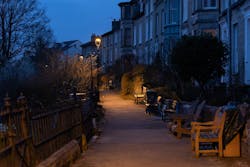Concerned about night skies, British county taps International Dark-Sky approved luminaires
When breathtaking natural beauty underpins your region’s economy, it’s sensible to ensure that outdoor lighting doesn’t spoil one of the area’s renowned attributes: glorious night skies. That’s why officials in and near England’s Lake District say they recently tapped Thorn Lighting.
“Cumbria has got some of the darkest skies in the United Kingdom,” said Ian Harker, lighting manager for Cumbria County Council, which has jurisdiction in England’s northwest including the world famous Lake District, a national park that attracts over 20 million visitors a year to gander at and walk among its dramatic peaks, stunning lakes, woodlands, and grassy meadows. (The county as a whole has about 47 million visitors, according to the Cumbria Local Enterprise Partnership).
Many of those visitors also venture out to look at the “dark skies,” otherwise known as the brilliantly starlit skies. Too much artificial light can ruin those views. As the person leading various outdoor lighting initiatives in Cumbria, Harker knows: “We need to be careful and mindful that we don’t make a negative impact.”
Related article: Canary Islands installs street lights that protect night skies
Cumbria recently upgraded lighting in two Lake District–associated locales — one smack dab in it and the other just outside — with two different styles of outdoor lamppost luminaires from Thorn. It also chose the company’s lighting for locations in two coastal towns outside of the Lake District. Thorn is the Spennymoor, England–based subsidiary of Dornbirn, Austria–based lighting company Zumtobel Group.
In all four cases, Cumbria was encouraged by Thorn’s certification from the International Dark-Sky Association, the Tucson, AZ nonprofit group committed to protecting night skies.
“All of the luminaires which have been installed as part of this project have the International Dark-[Sky] Association Fixture Seal of Approval, which is evidence of their ability to suit our dark-sky environment,” Harker said.
Thorn designed the LED luminaires to avoid light spill and glare, and to deliver minimal intensity and warmer color temperature, with settings that dim and warm in the middle of the night when less light is needed.
Related article: Turtle-friendly coastal lighting protects local habitat and promotes sustainability
One of the four projects, in the Lake District “gateway” town of Kendal (it sits next to official Lake District territory), replaced the lights in front of a row of early 19th-century houses with Thorn’s EP145 post-top lanterns, which match the Victorian style of the cast-iron columns they sit on.
Resident Lucy Bound is impressed.
“The light is much less intense,” she says, comparing it to the previous lanterns. “And it’s actually lighting up where you want it to light now. Before, it was kind of lighting up our gardens and lighting up our houses, but wasn’t actually lighting up where you wanted to walk. So what’s really lovely now is that the light’s in the right place and the gardens now at night are dark, which is really good for wildlife.”
Thorn installed its modern-looking Purio post-top luminaires in the Lake District village of Glenridding, and in the coastal towns of Workington and Whitehaven. Glenridding is lighting a small neighborhood cul-de-sac; the coastal towns are lighting parks. All three are using Thorn’s NightTune system, which adjusts light levels and color temperature to suit the time of night and the presence of people or vehicles.
“Dark skies are definitely a draw for us and the whole of the Lake District,” said Rob Shepherd, a Glenridding councillor. “The feedback has all been very positive. Obviously what’s great about [the lights] is they’re not just good for the wildlife, they’re better for the residents who are living next to the lights. It’s better for them to have the ability to tune them down overnight. We are looking to replace all of the other lights that we own as a parish with the same type.”
None of the parties revealed how much Cumbria paid for the lighting. Thorn told LEDs Magazine that to date it has installed 160 Purio lanterns with NightTune.
More are expected. Ironically, in a perfect world, “none” would be ideal. But where public spaces require lighting, night-sky friendly is the way to go, especially in a setting like the Lake District, which over the years has inspired poets like Wordsworth, and which for all its picturesque allure gained UNESCO World Heritage status in 2017. Thorn also recently lit another UNESCO site in Britain, Durham Cathedral.
UNESCO — the United Nations Educational, Scientific and Cultural Organization — grants World Heritage status to “encourage the identification, protection and preservation of cultural and natural heritage around the world considered to be of outstanding value to humanity.” It lists 1154 properties with the designation.
MARK HALPER is a contributing editor for LEDs Magazine, and an energy, technology, and business journalist ([email protected]).
For up-to-the-minute LED and SSL updates, follow us on Twitter. You’ll find curated content and commentary, as well as information on industry events, webcasts, and surveys on our LinkedIn page and our Facebook page.

Mark Halper | Contributing Editor, LEDs Magazine, and Business/Energy/Technology Journalist
Mark Halper is a freelance business, technology, and science journalist who covers everything from media moguls to subatomic particles. Halper has written from locations around the world for TIME Magazine, Fortune, Forbes, the New York Times, the Financial Times, the Guardian, CBS, Wired, and many others. A US citizen living in Britain, he cut his journalism teeth cutting and pasting copy for an English-language daily newspaper in Mexico City. Halper has a BA in history from Cornell University.








